Ncsbn lesson 6 - Study guides, Class notes & Summaries
Looking for the best study guides, study notes and summaries about Ncsbn lesson 6? On this page you'll find 26 study documents about Ncsbn lesson 6.
Page 2 out of 26 results
Sort by
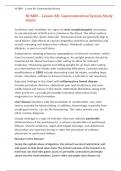
-
NCSBN – Lesson 8D: Gastrointestinal System Study Guide,100% CORRECT
- Exam (elaborations) • 57 pages • 2023
- Available in package deal
-
- $16.39
- + learn more
NCSBN – Lesson 8D: Gastrointestinal System Study Guide Confusion and irritability are signs of renal encephalopathy secondary to elevated levels of BUN and creatinine in the blood. The other options do not explain the client's behavior. Potassium levels are generally high in renal failure. Side effects of calcium depletion manifest as abdominal and muscle cramping and hyperactive reflexes. Metabolic acidosis, not alkalosis, is seen in renal failure. Eating before sleeping enhances regurgi...
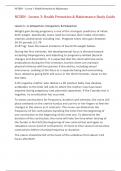
-
NCSBN - Lesson 3: Health Promotion & Maintenance Study Guide,100% CORRECT
- Exam (elaborations) • 108 pages • 2023
- Available in package deal
-
- $15.99
- + learn more
NCSBN - Lesson 3: Health Promotion & Maintenance Study Guide Lesson 3 – A: Antepartum, Intrapartum, & Postpartum Weight gain during pregnancy is one of the strongest predictors of infant birth weight. Specifically, teens need to increase their intake of protein, vitamins and minerals including iron. Pregnant teens who gain between 26-35 pounds (11.79- 15.87 kg) have the lowest incidence of low-birth-weight babies. During the first trimester, the developmental focus is directed toward ac...

-
NCSBN Practice Questions 121-131 Questions and Answers 2023
- Exam (elaborations) • 40 pages • 2023
- Available in package deal
-
- $27.49
- + learn more
NCSBN Practice Questions 121-131 Questions and Answers 2023 It is the start of the shift and the nurse has just finished listening to a report on four clients. Which client should the nurse assess first? A. A client with a diagnosis of an acute traumatic brain injury who has a blood pressure of 88/58 B. A client with a diagnosis of a concussion and who doesn't remember the motor vehicle accident C. A client diagnosed with viral meningitis and has signs of meningeal irritation D. A client...
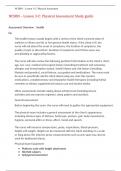
-
NCSBN – Lesson 3-C: Physical Assessment Study guide,100% CORRECT
- Exam (elaborations) • 45 pages • 2023
- Available in package deal
-
- $15.99
- + learn more
NCSBN – Lesson 3-C: Physical Assessment Study guide Assessment Overview Health Hx The health history usually begins with a review of the client's present state of wellness or illness and his or her general health status. If the client is ill, the nurse will ask about the onset of symptoms, the location of symptoms, the quality of pain or discomfort, duration of symptoms and if there were any precipitating or aggravating factors. The nurse will also review the following pert...
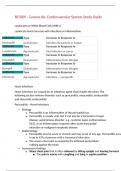
-
NCSBN – Lesson 8A: Cardiovascular System Study Guide,100% CORRECT
- Exam (elaborations) • 108 pages • 2023
- Available in package deal
-
- $15.99
- + learn more
NCSBN – Lesson 8A: Cardiovascular System Study Guide Leukocytes or White Blood Cells (WBCs) Leukocyte levels increase with infections or inflammation. Leukocyte Type Granulocyte Increases in Response to Infection by bacteria or fungus Neutrophil Leukocyte Type Agranulocyte Increases in Response to Viral infection or tumor Lymphocyte Leukocyte Type Granulocyte Increases in Response to Inflammation from allergies Eosinophil Leukocyte Type Granulocyte Increases in Respo...
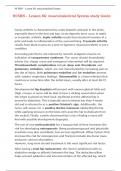
-
NCSBN – Lesson 8G: musculoskeletal System study Guide,100% CORRECT
- Exam (elaborations) • 78 pages • 2023
- Available in package deal
-
- $16.49
- + learn more
NCSBN – Lesson 8G: musculoskeletal System study Guide Gouty arthritis is characterized by urate deposits and pain in the joints, especially those in the feet and legs. Urate deposits don't occur in septic or traumatic arthritis. Septic arthritis results from bacterial invasion of a joint and leads to inflammation of the synovial lining. Traumatic arthritis results from blunt trauma to a joint or ligament. Seasonal arthritis is not a condition. Increasing pain that is not relieved by nar...
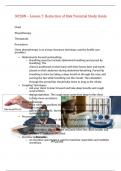
-
NCSBN – Lesson 7: Reduction of Risk Potential Study Guide,100% CORRECT
- Exam (elaborations) • 116 pages • 2023
-
- $15.49
- + learn more
NCSBN – Lesson 7: Reduction of Risk Potential Study Guide Chest Physiotherapy Therapeutic Procedures Chest physiotherapy is an airway clearance technique used by health care providers. • Abdominal & Pursed Lip Breathing o Breathing exercises include abdominal breathing and pursed lip breathing. The client is positioned on their back with their knees bent and hands placed on their abdomen during abdominal breathing. Pursed lip breathing is done by taking a deep breath in through the no...

-
NCSBN – Lesson 8A: Cardiovascular System Study Guide,100% CORRECT
- Exam (elaborations) • 108 pages • 2023
-
- $16.49
- + learn more
NCSBN – Lesson 8A: Cardiovascular System Study Guide Leukocytes or White Blood Cells (WBCs) Leukocyte levels increase with infections or inflammation. Leukocyte Type Granulocyte Increases in Response to Infection by bacteria or fungus Neutrophil Leukocyte Type Agranulocyte Increases in Response to Viral infection or tumor Lymphocyte Leukocyte Type Granulocyte Increases in Response to Inflammation from allergies Eosinophil Leukocyte Type Granulocyte Increases in Respo...
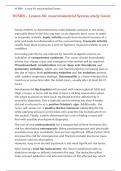
-
NCSBN – Lesson 8G: musculoskeletal System study Guide,100% CORRECT
- Exam (elaborations) • 78 pages • 2023
-
- $15.99
- + learn more
NCSBN – Lesson 8G: musculoskeletal System study Guide Gouty arthritis is characterized by urate deposits and pain in the joints, especially those in the feet and legs. Urate deposits don't occur in septic or traumatic arthritis. Septic arthritis results from bacterial invasion of a joint and leads to inflammation of the synovial lining. Traumatic arthritis results from blunt trauma to a joint or ligament. Seasonal arthritis is not a condition. Increasing pain that is not relieved by nar...
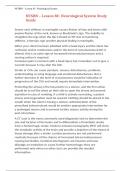
-
NCSBN – Lesson 8C: Neurological System Study Guide,100% CORRECT
- Exam (elaborations) • 97 pages • 2023
- Available in package deal
-
- $15.49
- + learn more
NCSBN – Lesson 8C: Neurological System Study Guide Severe neck stiffness in meningitis causes flexion of hips and knees with passive flexion of the neck, known as Brudzinski's sign. The inability to straighten the legs when the hip is flexed to 90° due to hamstring stiffness, is Kernig's sign another physical finding in meningitis. When your client has been admitted with a head injury and the client has confusion and/or restlessness and/or the level of consciousness (LOC) is altered, th...

$6.50 for your textbook summary multiplied by 100 fellow students... Do the math: that's a lot of money! Don't be a thief of your own wallet and start uploading yours now. Discover all about earning on Stuvia


